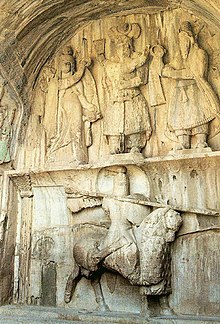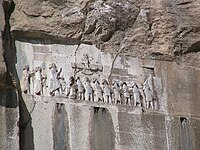Kermanshah province
Kermanshah Province
Kermanshahi | |
|---|---|
| Time zone | UTC+03:30 (IRST) |
| ISO 3166 code | IR-05 |
| Main language(s) | Kurdish local Persian official[2][3] |
| HDI (2017) | 0.796[4] high · 14th |
| Year | Pop. | ±% |
|---|---|---|
| 1996 | 1,778,596 | — |
| 2006 | 1,879,385 | +5.7% |
| 2011 | 1,945,227 | +3.5% |
| 2016 | 1,952,434 | +0.4% |
| amar.org.ir | ||
Kermanshah Province (
At the time of the National Census conducted in 2006, the population of Kermanshah province was 1,842,457 in 444,185 households.[12] By the time of the following census in 2011, there were 1,945,227 people in 530,911 households.[13] At the latest census in 2016, Kermanshah had a population of 1,952,434 in 576,861 households.[1]
Geography
Kermanshah province is located in western Iran. It shares borders with the provinces of Kurdistan, Hamadan, Lorestan, and Ilam within Iran.[14] It also shares borders with the Iraqi governorates of Halabja, Sulaymaniyah and Diyala.[15] Major cities and towns besides the capital include Eslamabad-e Gharb, Gilan-e Gharb, Harsin, Javanrud, Kangavar, Paveh, Qasr-e Shirin, Ravansar, Sahneh, Sarpol-e Zahab, and Sonqor.
Climate
As it is situated between two cold and warm regions, Kermanshah province enjoys a moderate and mountainous climate. It rains most in winter and is moderately warm in summer. The annual rainfall is 500 mm. The average temperature in the hottest months is above 22 °C.[citation needed]
History

The province has a rich Paleolithic heritage. Many caves with
The monuments found in Kermanshah show two glorious periods, the
The city suffered major damage during the
During the
The November 2017 Iran–Iraq earthquake killed more than 600 people.
On 28 December 2017, Kermanshah became one of several Iranian provinces to break out into protests. The Supreme Leader of Iran has blamed western interference. Some female organizations such as The National Council of Resistance of Iran (NCRI) have taken partial credit for the organization of these protests.[18][19]
Administrative divisions
| Administrative Divisions | 2006[12] | 2011[13] | 2016[1] |
|---|---|---|---|
| Dalahu County | 42,310 | 39,837 | 35,987 |
| Eslamabad-e Gharb County | 149,376 | 151,473 | 140,876 |
| Gilan-e Gharb County | 60,671 | 62,858 | 57,007 |
| Harsin County | 90,452 | 86,342 | 78,350 |
| Javanrud County | 62,259 | 71,235 | 75,169 |
| Kangavar County | 80,215 | 81,051 | 76,216 |
| Kermanshah County | 950,400 | 1,030,978 | 1,083,833 |
| Paveh County | 51,755 | 56,837 | 60,431 |
| Qasr-e Shirin County | 19,821 | 25,517 | 23,929 |
| Ravansar County | 44,983 | 46,395 | 47,657 |
| Sahneh County | 75,827 | 76,678 | 70,757 |
| Salas-e Babajani County | 37,056 | 38,475 | 35,219 |
| Sarpol-e Zahab County | 81,428 | 85,616 | 85,342 |
| Sonqor County | 95,904 | 91,935 | 81,661 |
| Total | 1,842,457 | 1,945,227 | 1,952,434 |
Cities
According to the 2016 census, 1,468,615 people (over 75% of the population of Kermanshah province) live in the following cities:
City of Kermanshah
The province's capital is
The distance between Kermanshah and
Economy
International and border trade
Kermanshah province has 371 km of common border with Iraq.There are five official border markets in the province. Three of these neighbor the Kurdish part of Iraq and the other two the Iraqi central government (Khosravi, Sumar). Based on figures from 9 November 2021, with a share of 5.7 to 6 percent Kermanshah province is among the first five exporters of non-oil products of Iran. Around 30 to 35 percent of theses
Exports from Kermanshah Province hit $2.7 billion in the fiscal year 2021-22 (ending 20 March), registering a 15% growth compared with the previous year, according to a local official.
The province's share in Iran's total exports during the period stood at 10% in terms of tonnage and 12% in value.
Kermanshah's share in total exports to Iraq stood at 53% and share in non-oil goods reached 43%.
Non-oil exports from Kermanshah mainly include tomato and tomato paste, air conditioners, cheese, industrial oil and their derivatives, biscuit, different types of melon, watermelon, tile and ceramic, plastic bags, marble, yogurt, milk, cream, cucumber, eggplant, apple and melamine dishes.[21]
Local products
Kermanshah lends its name to a type of Persian carpet named after the region. It also has famous sweets made of rice, locally known as Nan-e berenji.[22] The other famous Kermanshahi good is a special kind of oil, locally known as Rüne Dân and globally in Iran known as Roghan Kermanshahi. The Giveh of Kermanshah known as Klash is the highest quality Giveh.
Historical attractions
Various attractions exist that date from the pre-Islamic era, such as the Kohneh Bridge, to contemporary parks and museums. Some of the more popular sites are:
- Bisotun:

Darius the Great's Behistun inscription
- Gaumata. The location of this important historical document is not coincidental: Gaumata, a usurper who is depicted as lying at Darius' feet, was a Medean and in Achaemenid times Behistun lay on the Medea-Parsa highway.

- Behistun is also notable for three reliefs at the foot of the hill that date from the Parthian era. Among them is a Hellenistic-era depiction of the divinity Bahram as the Greek hero Hercules, who reclines with a goblet in his hand, a club at his feet and a lion-skin beneath him. Because it lies on the route of an ancient highway, this life-size rock sculpture may reflect Bahram's status as patron divinity of travelers.
- The rock reliefs at Taq-e Bostan lie 6 kilometres (4 mi) northeast of Kermanshah, where a spring gushes from a mountain cliff and empties into a large reflecting pool. One of the more impressive reliefs, inside the largest grotto (ivan), is the oversized depiction of Sassanid king Khosrau II(591–628 CE), who appears mounted on his favorite charger, Shabdiz. Both the horse and the rider are arrayed in full battle armor.
- There are two hunting scenes on complementary sides of the ivan: one depicts an imperial boar hunt and the other depicting the king stalking deer. Elephants flush out the boar from a marshy lake for the king who stands poised with bow and arrow in hand while he is serenaded by female musicians following in other boats. These royal hunting scenes are narrative murals in stone are count among the most vivid of all Iranian rock reliefs.
- The Taq-e Bostan reliefs are not limited to the Sassanid era. An upper relief depicts the 19th century Qajar king Fath-Ali shah holding court.
- The Kangavar archaeological complex:
- Kangavar is the site of the archaeological remains of a vast Hellenic-style edifice on a raised platform. The visible remains at the site date to early Sassanid times,[24] but the platform of the complex may be several centuries older. By the time excavation began in 1968, the complex had been preemptorily associated with a comment by Isidore of Charax who referred to a temple of Anahita at Concobar (the Greek name of Kangavar, which was then in Lower Medea). Despite archaeological findings to the contrary,[24] the association with the divinity of fertility, healing, and wisdom has made the site a popular tourist attraction. The vast edifice was built of enormous blocks of dressed stone with an imposing entrance of opposed staircases that may have been inspired by the Apadana in Persepolis.[25]
Anthropology
Kermanshah province is one of those provinces of Iran where different ethnic and religious groups live.
Higher education
Higher education and research
- Kermanshah University of Medical Sciences[28]
- Razi University[29]
- Islamic Azad University of Kermanshah[30]
Notable people

One of the renowned scientists and writers of this region is
See also
- Kalhor
- History of Kermanshah
- Iran - Iraq war
References
- ^ a b c d e "Census of the Islamic Republic of Iran, 1395 (2016)". AMAR (in Persian). The Statistical Center of Iran. p. 05. Archived from the original (Excel) on 3 April 2022. Retrieved 19 December 2022.
- ^ "Welcome to Encyclopaedia Iranica".
- )
- ^ "Sub-national HDI - Area Database - Global Data Lab". hdi.globaldatalab.org. Retrieved 13 September 2018.
- ^ "Li Kirmaşan erdhej" (in Kurdish). 1 October 2018. Archived from the original on 13 June 2020. Retrieved 18 March 2020.
- ^ "بەرپرسانی ڕێژیم بەڵێنی درۆ و بێ بنەما بە خەڵکی لێقەوماوی پارێزگای کرماشان دەدەن" (in Kurdish). Retrieved 18 March 2020.
- ^ Natiq Nouri, Ali Akbar (8 February 1372). "Law on changing the name of Bakhtaran province to Kermanshah". Research Center of the System of Laws of the Islamic Council of Farabi Mobile Library (in Persian). Shura Council. Archived from the original on 27 January 2013. Retrieved 5 March 2024.
- ^ "همشهری آنلاین-استانهای کشور به ۵ منطقه تقسیم شدند (Provinces were divided into 5 regions)". Hamshahri Online (in Persian). 22 June 2014. Archived from the original on 23 June 2014.
- ^ www.justice.gov/sites/default/files
- ^ "artkermanshah.ir". Archived from the original on 29 September 2018. Retrieved 16 July 2017.
- ^ "Ahmady, Kameel. A Peace-Oriented Investigation of the Ethnic Identity Challenge in Iran (A Study of Five Iranian Ethnic Groups with the GT Method), 2022, 13th Eurasian Conferences on Language and Social Sciences pp. 591–624". 13th Eurasian Conferences on Language and Social Sciences.
- ^ a b "Census of the Islamic Republic of Iran, 1385 (2006)". AMAR (in Persian). The Statistical Center of Iran. p. 05. Archived from the original (Excel) on 20 September 2011. Retrieved 25 September 2022.
- ^ a b "Census of the Islamic Republic of Iran, 1390 (2011)". Syracuse University (in Persian). The Statistical Center of Iran. p. 05. Archived from the original (Excel) on 18 January 2023. Retrieved 19 December 2022.
- ^ "Kermanshah Province".
- ^ "معرفی استان دیالی". Archived from the original on 20 November 2022. Retrieved 20 November 2022.
- ^ "Most ancient Mid East village discovered in western Iran". 2009. Archived from the original on 1 February 2010. Retrieved 23 May 2009.
- ^ "با 11800 سال قدمت، قديميترين روستاي خاورميانه در كرمانشاه كشف شد". 2009. Retrieved 23 May 2009. [dead link]
- ^ "Iran: Women keep high the spirit of nationwide protests" Archived 14 January 2018 at the Wayback Machine, The National Council of Resistance of Iran
- ^ "Ahmady, Kameel. Investigation of the Ethnic Identity Challenge in Iran- A Peace-Oriented". Efflatounia. 5 (2): 3242–3270. 2021.
- ^ "کرمانشاه جزو 5 استان اول ایران از نظر صادرات غیرنفتی است". 9 November 2021.
- ^ a b "With $2.7b, Kermanshah Accounts for 12% of Iran's Goods Export". 26 April 2022.
- ^ "طرز تهیه شیرینی نان برنجی خوشمزه مرحله به مرحله". 9 February 2022.
- ^ CHN Press release (2006). "Iran's Bisotoon Historical Site Registered in World Heritage List".
- ^ a b Kleiss, Wolfram (2005). "Kangavar". Encyclopedia Iranica. Costa Mesa: Mazda.
- ^ a b Ahmady, Kameel 2019: From Border to Border. Comprehensive research study on identity and ethnicity in Iran. Mehri publication, London.
- ^ KUMS. "About Kermanshah". KUMS. Retrieved 6 October 2023.
- ^ "Kermanshah, Iran Metro Area Population 1950-2023". macrotrends.net. Retrieved 6 October 2023.
- ^ "Home". kums.ac.ir.
- ^ "Home". razi.ac.ir.
- ^ "Home". en.iauksh.ac.ir. Archived from the original on 18 January 2022. Retrieved 8 August 2022.
Sources
- Borijan, Habib (2015). "KERMANSHAH i. Geography". Encyclopaedia Iranica.
- Borijan, Habib (2016). "KERMANSHAH vii. Languages and Dialects". Encyclopaedia Iranica.
- Calmard, Jean (2015). "KERMANSHAH iv. History from the Arab Conquest to 1953". Encyclopaedia Iranica.
- Pirnazar, Nahid (2014). "KERMANSHAH viii. The Jewish Community". Encyclopaedia Iranica.
Bibliography
- ISBN 9786206769538.
External links
- Kirmashan website, Kurdish Culture
- Yarsan
- A Persian article about Giveh Archived 27 September 2007 at the Wayback Machine


